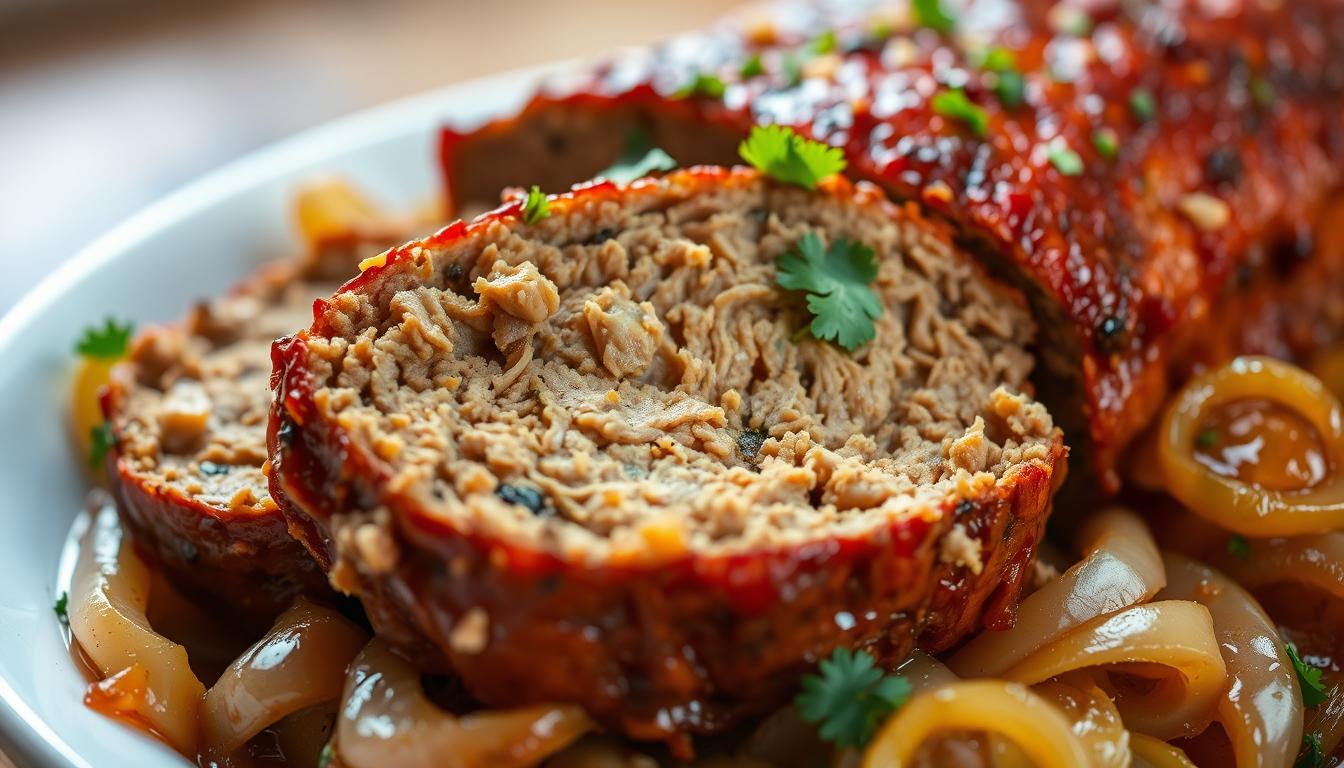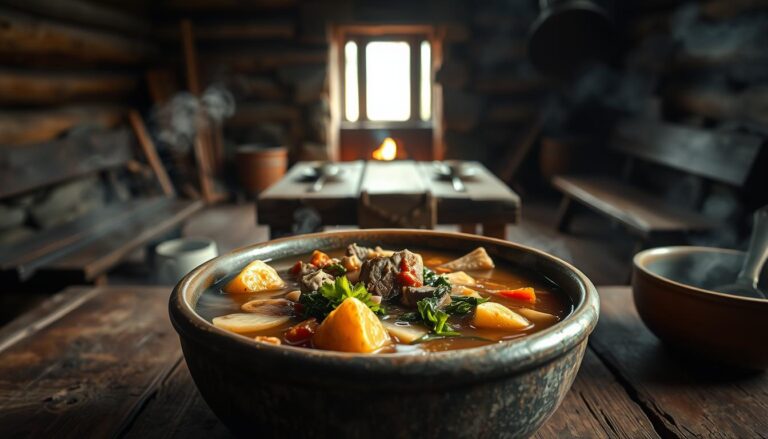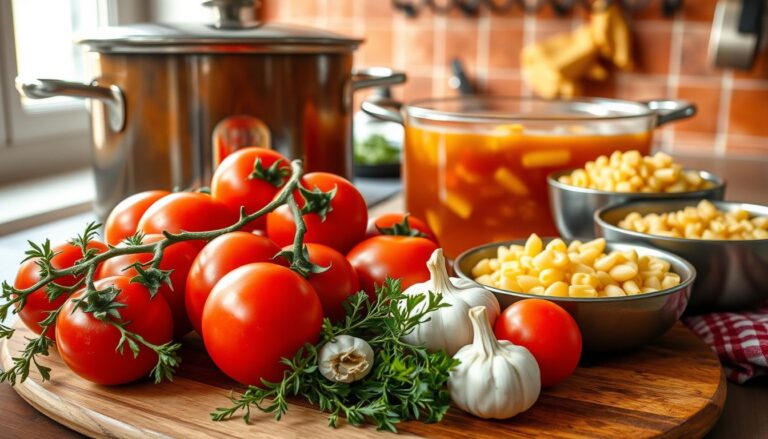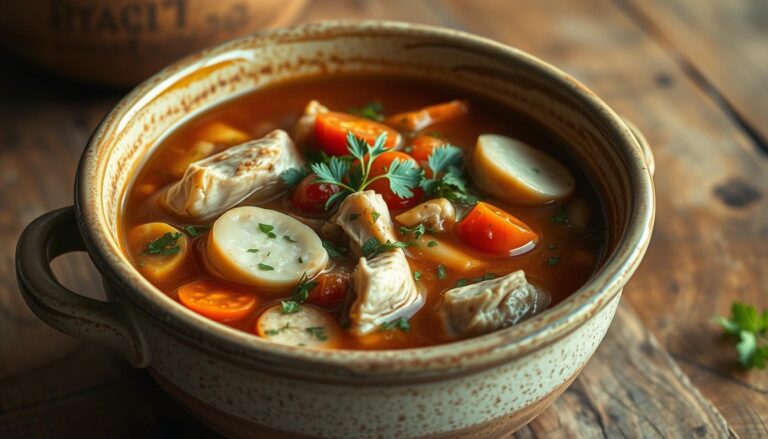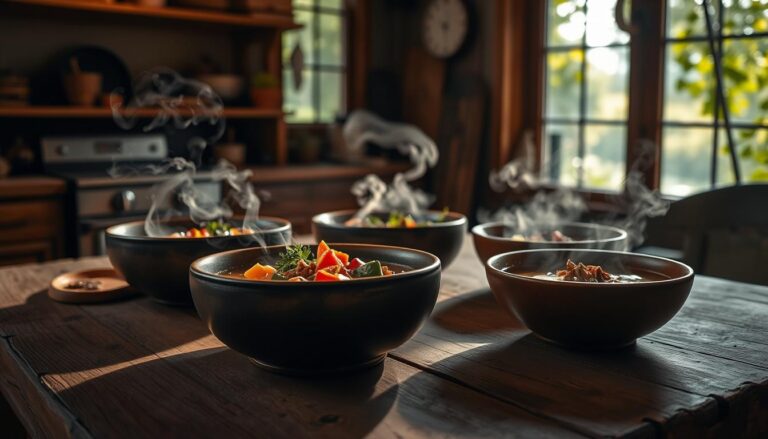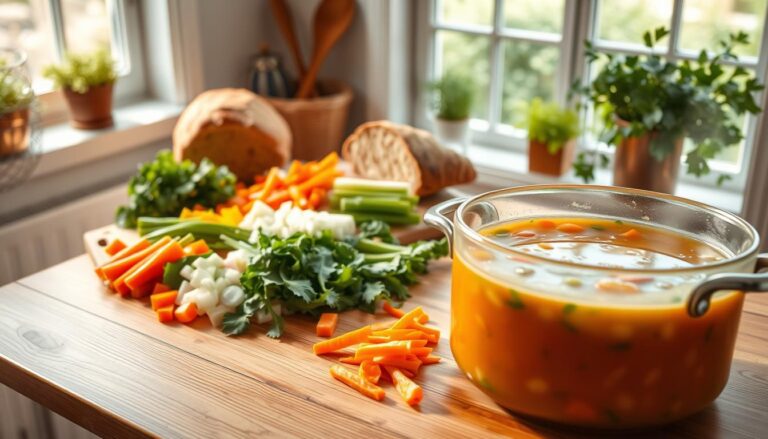What if the key to a mouthwatering, perfectly moist dish has been hiding in your pantry all along? For decades, home cooks have turned to a simple yet powerful ingredient to elevate their meals. This article explores how a classic recipe can be transformed into a family favorite with just one secret addition.
Rooted in tradition, this dish has been a staple in American kitchens since the early 20th century. The use of onion soup mix brings a depth of flavor that’s both nostalgic and innovative. Whether you’re a seasoned chef or a beginner, this recipe is designed to deliver consistent, delicious results every time.
In the following sections, you’ll discover step-by-step instructions, expert tips, and creative twists to make this dish your own. Get ready to impress your family and friends with a recipe that’s as easy as it is flavorful!
Table of Contents
The Timeless Appeal of Meatloaf
From humble beginnings to family dinner tables, this dish has earned its place in culinary history. Its enduring popularity is a testament to its simplicity, versatility, and ability to bring people together. Whether served as a weeknight dinner or a holiday centerpiece, it remains a beloved comfort food for many.
A Rich Culinary History
Meatloaf’s origins can be traced back to early cookbooks, with recipes appearing as early as the 19th century. By the 1930s, it had become a staple in American households, thanks to its affordability and ease of preparation. The 1936 cookbook “The Joy of Cooking” featured a version that closely resembles the dish we know today.
Over the decades, the recipe evolved, incorporating new ingredients and techniques. The addition of soup mix in the mid-20th century brought a new depth of flavor, making it even more irresistible. This innovation helped solidify its status as a family favorite.
Family Favorite Status
What makes this dish so special is its ability to evoke memories of shared meals and cherished traditions. For many, it’s a reminder of Sunday dinners with loved ones or a comforting meal after a long day. Its versatility allows for endless customization, ensuring it never gets boring.
Ingredients like ground beef and Lipton Onion Soup Mix play a crucial role in creating the perfect balance of flavor and texture. These elements, combined with its nostalgic appeal, make it a dish that continues to unite generations.
| Year | Milestone |
|---|---|
| 19th Century | Early meatloaf recipes appear in cookbooks. |
| 1936 | “The Joy of Cooking” features a classic version. |
| Mid-20th Century | Soup mix is introduced, enhancing flavor. |
| Present Day | Remains a staple in family kitchens nationwide. |
Key Ingredients for a Flavorful Meatloaf
The secret to a flavorful dish lies in the quality of its ingredients. Selecting the right components ensures your recipe turns out moist, tender, and packed with savory goodness. Let’s dive into the essentials that make this dish a standout.
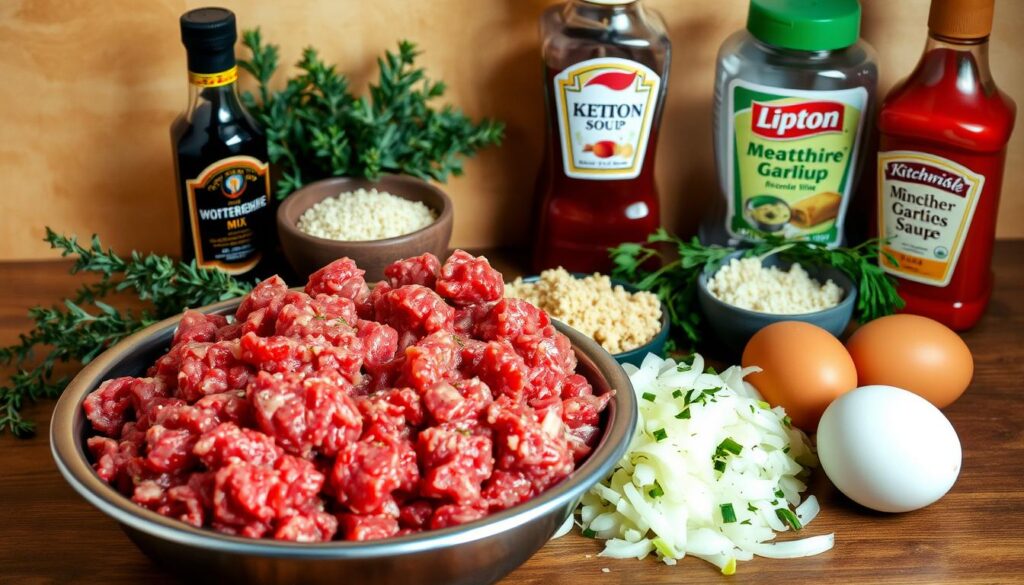
The Power of Lipton Onion Soup Mix
One of the key ingredients that elevate this dish is the onion soup mix. It adds a rich, savory flavor that enhances the overall taste. The blend of dehydrated onions, spices, and seasonings creates a depth of flavor that’s hard to replicate with other ingredients.
Using a packet of this mix ensures consistency and eliminates the need for additional seasonings. It’s a time-saving hack that delivers restaurant-quality results every time.
Choosing the Right Ground Beef
The type of ground beef you use plays a crucial role in the texture and juiciness of your dish. Opt for a blend with an 85/15 or 90/10 fat ratio. This balance ensures the meat stays moist without becoming greasy.
Leaner cuts can result in a drier texture, while fattier blends may shrink excessively during cooking. Properly marbled beef is ideal for achieving the perfect consistency.
| Ingredient | Role |
|---|---|
| Onion Soup Mix | Adds savory flavor and seasoning |
| Ground Beef | Provides texture and moisture |
| Eggs | Binds ingredients together |
| Breadcrumbs | Helps retain moisture and structure |
When combining these ingredients, measure them carefully to maintain the right balance. Overmixing can lead to a dense texture, so handle the mixture gently. With the right components and techniques, your dish will be a guaranteed crowd-pleaser.
Step-by-Step Guide to Lipton Onion Soup Meatloaf Recipes
Crafting a delicious dish doesn’t have to be complicated—here’s how to make it simple and flavorful. Follow these steps to create a savory masterpiece that’s sure to impress.
Preparing Your Ingredients
Start by gathering all your ingredients. You’ll need 1.5 pounds of ground beef, 1 packet of Lipton Onion Soup Mix, 2 eggs, 1 cup of breadcrumbs, and ½ cup of milk. Don’t forget ⅓ cup of ketchup for added flavor.
Measure everything carefully to ensure the right balance. This step is crucial for achieving the perfect texture and taste.
Mixing and Shaping Techniques
In a large bowl, combine the ground beef, mix, eggs, breadcrumbs, and milk. Use your hands to gently blend the ingredients. Overmixing can lead to a dense texture, so handle the mixture with care.
Once combined, shape the mixture into a loaf. You can use a loaf pan for a traditional shape or a baking sheet for crispier edges. Both methods work well, so choose based on your preference.
Baking and Resting for Perfection
Preheat your oven to 350°F (175°C). Place the shaped loaf in the oven and bake for about 1 hour, or until the internal temperature reaches 165°F (75°C). This ensures it’s fully cooked and safe to eat.
After baking, let the dish rest for 5-10 minutes. This allows the juices to redistribute, keeping it moist and flavorful. Cutting it too soon can cause it to dry out.
| Step | Key Detail |
|---|---|
| Prepping | Measure all ingredients accurately. |
| Mixing | Combine gently to avoid overmixing. |
| Shaping | Use a loaf pan or baking sheet. |
| Baking | Cook at 350°F for 1 hour. |
| Resting | Wait 5-10 minutes before slicing. |
“The secret to a perfect dish lies in the details—measuring, mixing, and resting are just as important as the ingredients themselves.”
Mixing Techniques and Cooking Tips
Mastering the art of mixing can make or break your dish. The way you handle the mixture directly impacts its texture and flavor. Overmixing can lead to a dense, dry result, while gentle blending ensures a tender and juicy loaf.
Why Overmixing is a Mistake
Overworking the mixture can cause the proteins in the meat to tighten, resulting in a tough texture. To avoid this, mix the ingredients just until they’re combined. This keeps the dish light and moist.
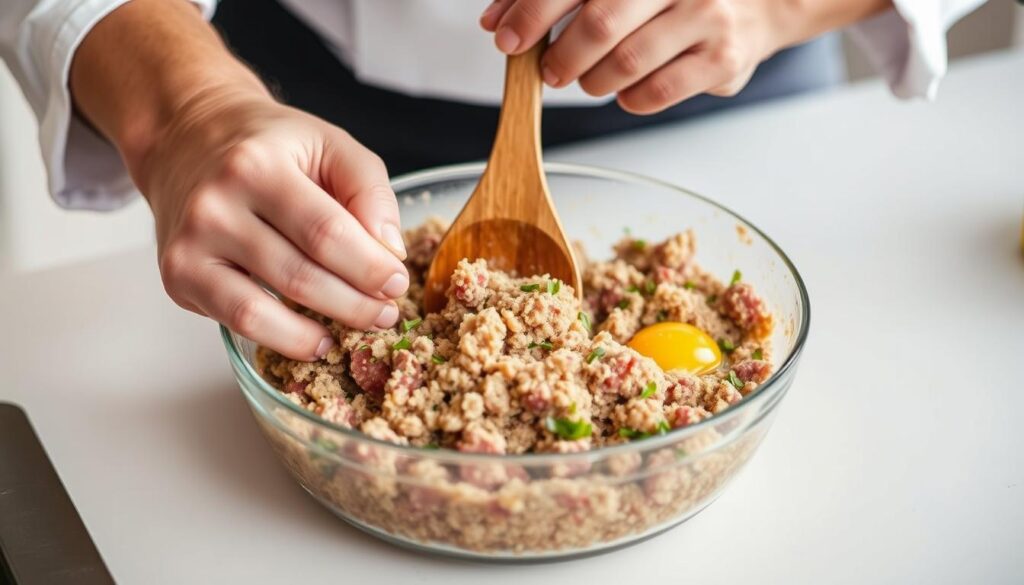
Best Practices for Even Mixing
Start by adding your dry ingredients to the bowl first. This ensures even distribution of flavors. Use your hands to gently combine the mixture, folding rather than squeezing. This technique helps maintain the dish’s tenderness.
- Incorporate eggs and breadcrumbs gradually to avoid clumping.
- Use a light touch to blend the ingredients without overworking them.
- Let the mixture rest for a few minutes before shaping to allow flavors to meld.
How Proper Mixing Enhances Texture
A well-mixed mixture ensures that every bite is flavorful and tender. It also helps the loaf hold its shape during cooking. Avoid compacting the mixture too tightly when shaping, as this can lead to a dense result.
“The key to a perfect dish lies in the balance of mixing—gentle enough to keep it tender, thorough enough to distribute the flavors evenly.”
By following these tips, you’ll create a dish that’s both delicious and satisfying. Whether you’re serving it fresh or enjoying leftover slices, the right mixing technique ensures a memorable meal every time.
Secrets to Achieving Perfect Moisture and Texture
Achieving the perfect balance of moisture and texture in your dish is easier than you think. The key lies in understanding a few essential techniques and ingredients. From selecting the right fat content to mastering your oven settings, these tips will ensure your dish stays tender and flavorful every time.

Using the Right Fat Content
The fat content in your meat plays a crucial role in keeping your dish moist. Opt for ground beef with an 80/20 lean-to-fat ratio. This balance ensures juiciness without making the dish greasy. For added moisture, consider mixing in a bit of bacon or extra fat.
Leaner cuts can result in a drier texture, while fattier blends may shrink excessively during cooking. Properly marbled beef is ideal for achieving the perfect consistency.
Oven Temperature and Timing
Your oven settings are just as important as the ingredients. Preheat your oven to 350°F (175°C) for even cooking. Bake the dish for about 1 hour, or until the internal temperature reaches 160°F (71°C). This ensures it’s fully cooked and safe to eat.
Covering the dish with aluminum foil for the first 30 minutes can help retain moisture. Remove the foil during the last half of baking to allow the top to brown slightly.
Checking Internal Temperature
Using a meat thermometer is the best way to ensure your dish is perfectly cooked. Insert it into the center of the loaf to check the internal temperature. Once it reaches 160°F, remove it from the oven and let it rest for 5-10 minutes. This allows the juices to redistribute, keeping every bite moist.
| Fat Content | Effect on Texture |
|---|---|
| 80/20 Lean-to-Fat | Moist and tender |
| 90/10 Lean-to-Fat | Leaner but can be drier |
| 70/30 Lean-to-Fat | Juicy but may shrink more |
“The right fat content and oven settings are the secrets to a dish that’s both moist and flavorful every time.”
Variations and Enhancements to Customize Your Meatloaf
Transform your dish into a healthier, more flavorful masterpiece with these simple swaps. Whether you’re cooking for your family or experimenting with new flavors, these tips will help you create a dish that’s both delicious and nutritious.
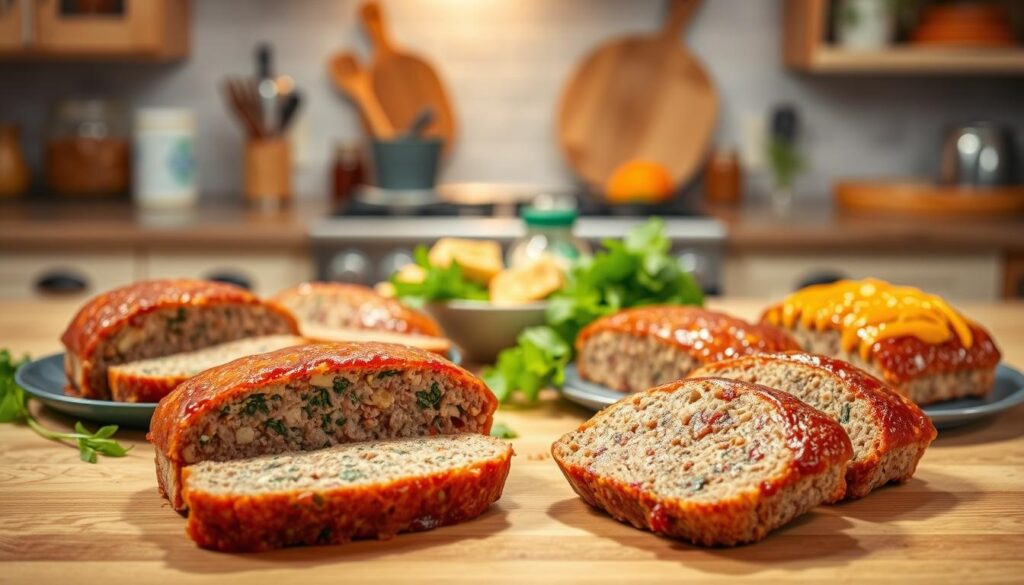
Healthy Ingredient Swaps
Making your dish healthier doesn’t mean sacrificing taste. Swap traditional breadcrumbs for quick oats or almond flour. These alternatives add texture while reducing carbs. For a leaner option, use ground turkey or chicken instead of beef. These changes keep your dish moist and flavorful.
Adding grated zucchini or carrots can boost moisture and nutrition. These vegetables blend seamlessly into the mixture, making them perfect for picky eaters. You’ll create a dish that’s both wholesome and satisfying.
Adding Extra Flavors: Herbs & More
Enhance your dish with fresh herbs like parsley, thyme, or rosemary. These additions bring a burst of flavor that elevates every slice. For a cheesy twist, mix in grated parmesan or cheddar. These ingredients add richness without overwhelming the dish.
Experiment with spices like smoked paprika or cumin for a unique twist. These bold flavors can transform your dish into a new family favorite. Don’t be afraid to get creative—your dish will thank you.
| Ingredient Swap | Benefit |
|---|---|
| Quick Oats | Adds texture, reduces carbs |
| Ground Turkey | Leaner, lower in fat |
| Grated Zucchini | Boosts moisture and nutrition |
| Fresh Herbs | Enhances flavor naturally |
“Small changes in ingredients can lead to big improvements in flavor and health. Don’t be afraid to experiment!”
With these variations, you can tailor your dish to suit any day or occasion. Whether you’re serving it fresh or enjoying leftover slices, these enhancements ensure a memorable meal every time.
Baking Methods: Loaf Pan vs. Baking Sheet
Choosing the right baking method can make all the difference in your final dish. Whether you use a loaf pan or a baking sheet, each option offers unique benefits that affect moisture, texture, and presentation. Understanding these differences helps you tailor your cooking to achieve the perfect result.
Benefits of Using a Loaf Pan
A loaf pan is a classic choice for baking. Its enclosed shape helps retain moisture, ensuring your dish stays tender and juicy. The pan also collects excess fat, which can be easily removed after cooking. This method is ideal for those who prefer a traditional, evenly cooked result.
For best results, line the pan with parchment paper or lightly grease it to prevent sticking. This ensures your dish slides out smoothly, maintaining its shape and presentation. Using a loaf pan is especially helpful when working with lean ground meat, as it prevents drying out.
Crispier Sides on a Sheet Pan
If you enjoy a crispier texture, a baking sheet is the way to go. The exposed sides of the dish brown evenly, creating a flavorful crust. This method is perfect for those who prefer a slightly firmer texture with a golden exterior.
To achieve the best results, shape your mixture into a loaf directly on the sheet. Use foil or parchment paper for easy cleanup. This technique works well with fattier blends, as the excess fat drips away during cooking, leaving a balanced, flavorful dish.
| Method | Key Benefit |
|---|---|
| Loaf Pan | Retains moisture, collects fat |
| Baking Sheet | Creates crispy edges, reduces grease |
“The right baking method can elevate your dish from good to great. Choose based on your desired texture and flavor.”
Whether you opt for a loaf pan or a baking sheet, both methods can turn your dish into a family favorite. Experiment with each to discover which suits your taste and style best.
Serving Suggestions and Leftover Innovations
Discover how to turn your leftovers into a culinary delight with these creative serving ideas. Whether you’re looking for a quick lunch or a complete meal, these tips will help you make the most of your dish.
Creating Delicious Sandwiches
Leftovers can be transformed into mouthwatering sandwiches. Simply slice your dish into thick pieces and layer them between slices of toasted bread. Add a spread of mayonnaise or mustard for extra flavor. For a gourmet touch, include fresh lettuce, tomato, and a slice of cheese.
Here’s a tip: Warm the slices slightly before assembling your sandwich. This enhances the flavor and makes every bite more enjoyable. Store any extra slices in an airtight container to keep them fresh for later use.
Complementary Side Dishes for a Complete Meal
Pair your dish with sides that enhance its flavor. Classic options like mashed potatoes or steamed green beans work beautifully. For a lighter choice, try a fresh garden salad or roasted vegetables.
- Mashed potatoes: Creamy and comforting, they complement the savory flavors.
- Steamed green beans: Add a crisp, fresh element to your plate.
- Roasted vegetables: A colorful and nutritious addition.
These sides not only complete your meal but also add variety to your dining experience. Remember to store leftovers in a container to maintain their freshness.
“A well-rounded meal is all about balance. Pair your dish with sides that bring out its best flavors.”
Here’s a note: Allow your dish to rest for 5-10 minutes before slicing. This helps retain its moisture and ensures a perfect texture. With these serving suggestions, you’ll turn every meal into a memorable experience.
Conclusion
Creating a dish that’s both flavorful and tender is easier than you think. Start with quality ingredients, like a loaf pan to retain moisture and a cup ketchup for added richness. Careful mixing ensures a perfect texture, while proper baking techniques guarantee even cooking.
Experiment with variations to make it your own. Whether you use a pan or a baking sheet, the results will be delicious. Don’t forget to check the internal temperature for safety and let it rest before serving.
Try this meatloaf recipe today and share your kitchen success stories. With these tips, you’ll create a dish that’s sure to become a family favorite.
FAQ
Why is Lipton Onion Soup Mix a key ingredient in meatloaf?
The mix adds a rich, savory flavor and helps keep the dish moist while enhancing its overall taste.
What type of ground beef works best for meatloaf?
Lean ground beef, with about 85% lean and 15% fat, provides the right balance of flavor and moisture.
Can I use a baking sheet instead of a loaf pan?
Yes, a baking sheet allows for crispier edges, while a loaf pan helps maintain a traditional shape.
How do I prevent my meatloaf from becoming dry?
Avoid overmixing the ingredients and ensure you use a mix with enough fat content for moisture.
What are some healthy swaps for traditional meatloaf ingredients?
You can use ground turkey, oats instead of breadcrumbs, or add grated vegetables for added nutrition.
How long should I let the meatloaf rest after baking?
Let it rest for about 10 minutes to allow the juices to redistribute, ensuring a moist and flavorful slice.
What are some creative ways to use leftover meatloaf?
Leftovers make excellent sandwiches, or you can crumble them into pasta sauces or salads for a quick meal.
Can I freeze meatloaf for later use?
Yes, wrap it tightly in foil or store it in an airtight container. It can be frozen for up to 3 months.
What side dishes pair well with meatloaf?
Classic options include mashed potatoes, roasted vegetables, or a fresh green salad for a balanced meal.
How can I add extra flavor to my meatloaf?
Incorporate herbs like thyme or rosemary, or add a glaze made with ketchup and brown sugar for a sweet and tangy finish.

